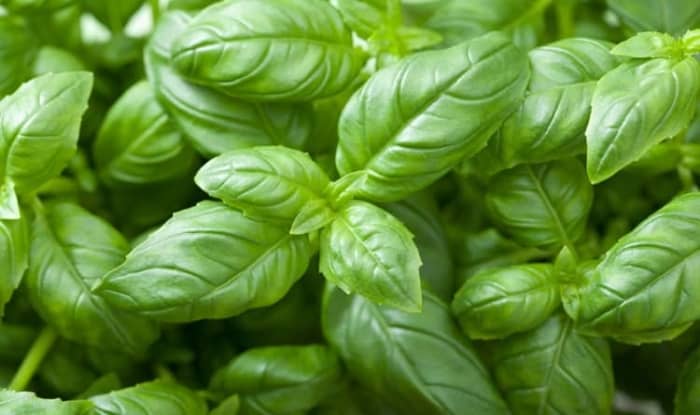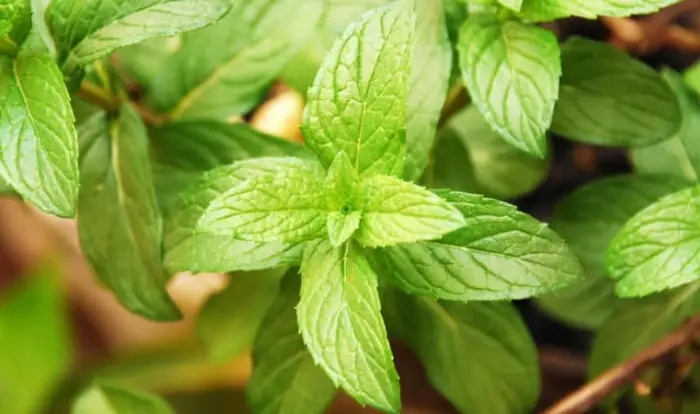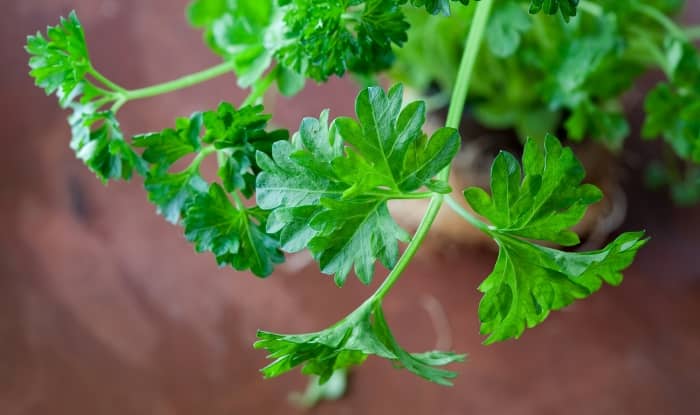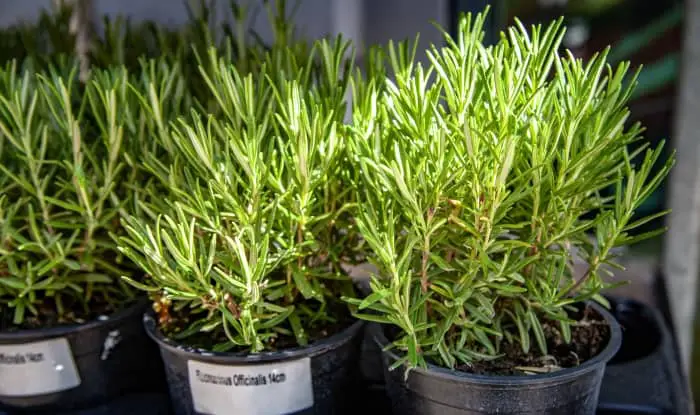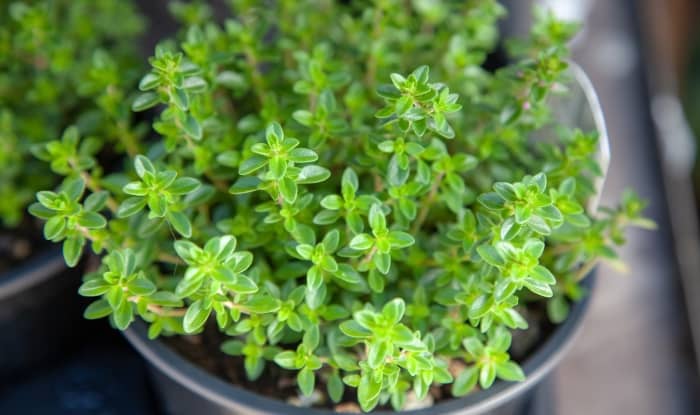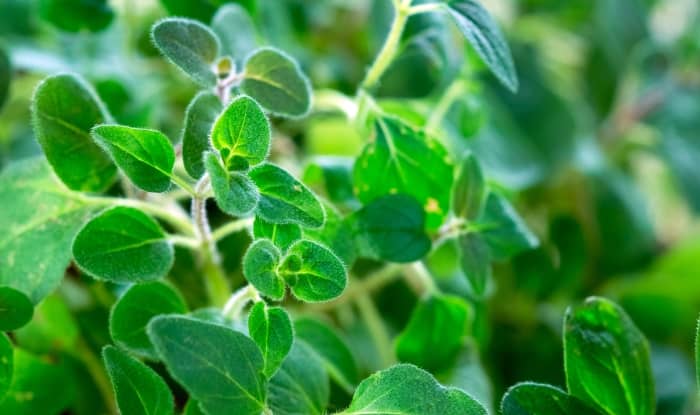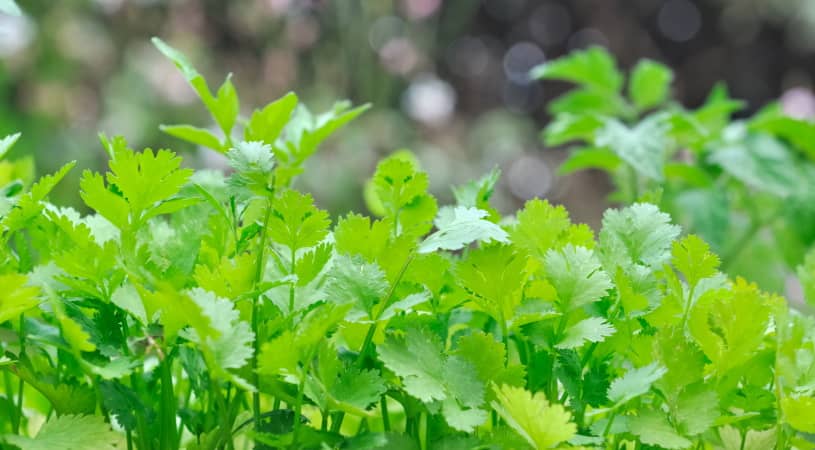The benefits of an indoor herb garden speak for themselves:
Fresh, healthy, flavorsome herbs all year round at your fingertips. And at a fraction of the price you’d pay in the store.
It’s easy to get started. Many herbs will grow from cuttings on a sunny windowsill year round. Or you can grow them from seeds.
So to help you take the first step, let’s take a look at the best herbs to grow indoors.
The Best Herbs To Grow Indoors
Basil
Basil is a popular herb that’s easy-to-grow. Its flavorsome green leaves go well in a range of cuisine, including sauces and salads. And it goes great when combined with tomatoes and creamy cheeses. Not only that, but it’s a must-have herb if you like making pesto.
You can grow it from seed or buy young plants and pot them in soil. It thrives in warm temperatures and bright sunlight. So if you can, try growing it in a southern or westerly facing window. And remember to water regularly.
The plant should be good to keep indoors and use for several weeks. But it’s not a houseplant you’ll keep for the long term. So it’s a good idea to plant new seeds every few weeks, if you use it regularly, to keep yourself in good supply.
Mint
Mint is a fast growing plant that’s ideal for planting in a container. It grows easily indoors when it gets at least 3-4 hours of direct sunlight each day. With ideal amounts being closer to 6 hours.
So you should look to keep it on a windowsill where it can get good sun exposure. The traditional advice when growing mint is to give it the morning sun and shade in the afternoon. Which makes east facing windows a good choice.
Make sure you water it at least every 2 or 3 days. And check to make sure that the soil is always kept moist.
There are many different varieties to choose from. With favorites including spearmint, peppermint, and chocolate mint. Pluck the leaves to make delicious mint tea, desserts, and salads.
Related: Growing Mint Indoors: A Step By Step Guide
Chives
Chives grow well in containers and ideally should be placed in a window with lots of light. South facing if you can.
With their distinctive onion like flavor (Allium schoenoprasum), or the garlicky flavor of garlic chives (Allium tuberosum), they make a versatile ingredient that you can add to salads and soup recipes.
Snip off the leaves or slice it down from the top into small chunks. Just make sure you leave 2 inches or more of growth so it can resprout.
Parsley
Parsley comes in two different types: curly or flat leaf. Both are full of flavor and can be cooked into soups and sauces, as well as making a nice addition to salads.
To get started growing it, get a container with drainage holes. Add a soil-less potting mix and sow the seeds around ¼ inch underneath the surface. With about 1-2 inches distance between them.
The plants should be grown in strong sunlight, so south facing windows are the best.
You can harvest the plant by pinching or snipping the stems at the base of the plant.
Rosemary
The needle-like leaves of rosemary are well known for the complementary flavor they add to a wide range of dishes. Including: lamb, chicken, sauces, and soups. You can throw an entire sprig into a soup while it cooks, or mince the leaves first.
Rosemary plants need a lot of sunlight. So make sure to place your plant in a south facing window so it can thrive. Make sure it gets at least 6-8 hours per day. If this isn’t possible you’ll need to use a fluorescent light bulb near the plant to supplement. Or use a grow light.
Make sure the container you use has good drainage, and water whenever the surface of the soil feels dry to the touch. But don’t let it dry out completely!
Thyme
Thyme is a commonly used ingredient in almost every cuisine you can name. Its fragrant green-gray leaves can be used to season many main dishes and desserts.
It prefers to be grown in direct sunlight, although it can tolerate indirect light. Place it near a southern or westen facing window where it can get at least 6 hours of daylight.
You should pot it in a container with good drainage, as problems develop if the roots are soggy.
To use, wait until the plant has a good amount of foliage and then pick the leaves off with your fingers.
Oregano
This heat-loving herb is commonly found in Mexican, Middle Eastern, and Mediterranean cooking. Add the leaves to sauces, stews, soups, meat, and casseroles.
Oregano comes in over 50 different types that have a slightly different flavor. Try growing sweet marjoram (Origanum majorana) for a spicy and sweet taste. Try Italian marjoram (O. x majoricum) if you like the taste of oregano without the sweetness. And consider pot marjoram (O. onites) for a more savory flavor.
It’s an easy to care for plant that comes from the mint family and does well in similar conditions.
Give it at least 6-8 hours of sunlight a day. And use a container with excellent drainage, allowing the soil to dry out a bit between each watering.
Bay
Native to the Mediterranean, Bay is a slow growing herb with long fragrant leaves that goes well with food and is used in a variety of soups, stews, and casseroles.
It grows well indoors in containers and is easy to care for, only needing the occasional watering and fast-draining soil.
Place the plant in a west or east facing window. And make sure it has good air circulation to prevent the transfer of disease. The problem? Bay is prone to infestation by the scale insect.
Sage
Used as a medicinal herb as well as a culinary ingredient in stuffing and poultry dishes, sage (Salvia officinalis) is simple to grow indoors in the right conditions.
It’s important to give it at least 6-8 hours of sunlight per day. So supplemental lighting is sometimes required if you can’t place it in a suitably sunny location.
A double fluorescent tube fixed underneath a countertop or kitchen cabinet is a good way of providing the extra light it needs if necessary. For every 1 hour of real light you’re substituting for, give it 2 hours under the lights.
Keep the plant in a warm location away from cold drafts. And use pots and soil with good drainage.
Water it occasionally, allowing the top inch of soil to dry out between times. Sage is relatively drought-tolerant so it’s forgiving if you sometimes forget.
Chervil
Chervil makes a good addition to any indoor herb garden. It’s an annual herb with a delicate scent, and it’s a key ingredient in the French ‘fines herbes’ blend. The anise-parsley flavor is distinctive and goes well with fish, eggs, potatoes, and salads.
Chervil seeds need to be planted shallowly in rich organic potting soil. Use a deep pot to allow room for its tap root to grow. The soil should be kept moist, but make sure it’s not soggy or the seeds may start to rot.
Chervil plants like the shade as well as cool temperatures (between 60-70 °F). So expose them to moderate sunlight.
Tips For Growing Herbs Indoors
Growing herbs indoors is easy to do, but there are some important things to consider:
Pests
When bringing herbs indoors from your garden, or when buying from a nursery, remember to check for pests. It’s not uncommon to find aphids, scale, or spider plants and it’s best to begin with a healthy and pest-free plant.
What are the tell-tale signs?
Aphids are tiny yellow or green insects. Even if you can’t see the aphids on the plant, they leave behind a black sticky substance known as honeydew. This is usually visible on the underside of leaves where the aphids like to hang out.
Scale insects are a common problem for plants grown indoors. The bugs that cause it are small and oval shaped with a brown shell. They’re usually found on the underside of leaves and around its joints. They also excrete honeydew, which enables the growth of sooty mold if left untreated.
The presence of spider mites can often be detected by the fine webs they leave between leaves.
As a treatment to get rid of these pests, try washing the affected areas with soapy water.
If you grow herbs indoors it’s best to make sure that the plants are not crowded together, and that there’s good air flow around individual plants. Why?
Because if you’re not careful these pests can quickly spread.
Light
Plants that have originated in tropical and subtropical regions of the world usually do well when placed near south facing windows. This makes sure they get the most sunlight. Favorite herbs that will appreciate these locations include thyme, rosemary, oregano, and basil.
East and west facing windows don’t have the same light intensity as south facing windows. The moderate sunlight they provide is good for herbs like mint and chives.
Alternatively, you can also use grow lights.
Soil & Water
Soggy soil can be fatal for many herbs. So it’s important to plant them in containers that have drainage holes. For soil, use a peat-free potting mix that contains a good level of organic matter. Make sure to keep the soil moist.
You can also use a liquid fertilizer 1-2 times per month on your indoor herbs if necessary.

